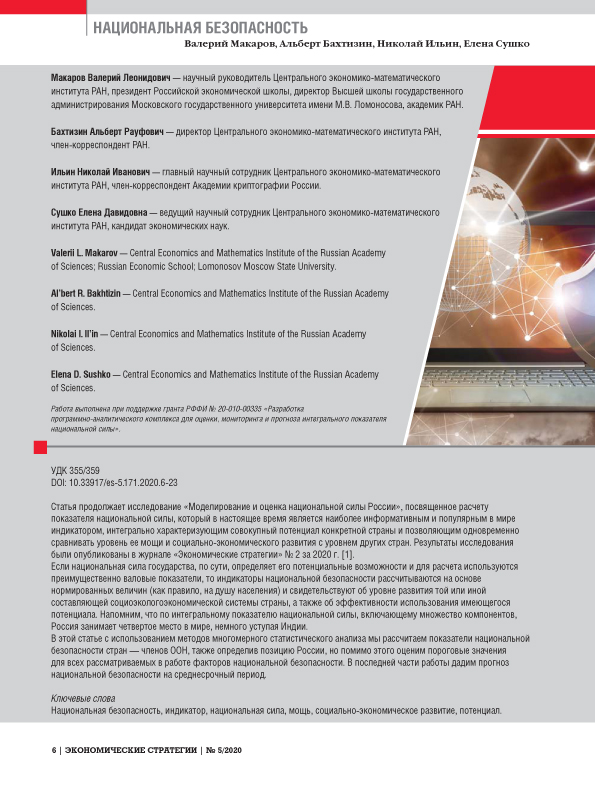National Security of Russia
DOI: 10.33917/es-5.171.2020.6-23
The article is continuing the research “Modelling and Assessment of Russia’s National Power”, dedicated to calculating the index of national power, which is currently the most informative and popular indicator in the world that integrally characterizes the aggregate potential of a particular country and allows at the same time to compare the level of its power and socio-economic development with the other countries’ level. The research results were published in the “Economic Strategies” magazine No. 2 for 2020. [1].
If the national power of the state, in fact, determines its potential capabilities and mainly gross indicators are used for the
calculation, then the national security indicators are calculated on the basis of normalized values (as a rule, per capita) and witness the development level of one or another component of the country’s socio-ecologic and economic system, as well as efficiency of using the existing potential. It should be reminded that in terms of the National Integral Strength Index, which includes many components, Russia ranks fourth in the world, slightly behind India. In this article, using the methods of multivariate statistical analysis, we’ll calculate the national security indicators of the UN member states, also defining the position of Russia, but in addition, we’ll also estimate the threshold values for all the factors of national security considered in the work. In the last part of the paper, we’ll give a medium-term forecast of national security
References:
1. Makarov V.L., Bakhtizin A.R., Il’in N.I. Modelirovanie i otsenka natsional’noi sily Rossii [Modeling and Assessing the National Strength of Russia]. Ekonomicheskie strategii, 2020, no 2, pp. 6–19. DOI: 10.33917/es-2.168.2020.6-19.
2. National Security Act of 1947 / Public Law 253, 80th Congress; Chapter 343, 1st Session. Central Intelligence Agency, 1947, July, 26, pp. 758, available at: https://www.cia.gov/library/readingroom/docs/1947-07-26.pdf.
3. National Security Strategy of the United States of America. The White House, 2017, December, available at: https://www.whitehouse.gov/wp-content/uploads/2017/12/NSS-Final-12-18-2017-0905.pdf.
4. National Security Strategy and Strategic Defence and Security Review 2015. A Secure and Prosperous United Kingdom, 2015, November, available at: https://www.gov.uk/government/publications/national-security-strategy-and-strategic-defence-and-security-review-2015.
5. National Security Strategy 2017. DSN, available at: https://www.dsn.gob.es/sites/dsn/files/2017_Spanish_National_Security_Strategy_0.pdf.
6. National Security Strategy. Government Offices of Sweden, available at: https://www.government.se/information-material/2017/10/national-securitystrategy.
7. Ukaz Prezidenta RF ot 31 dekabrya 2015 g. N 683 “O Strategii natsional’noi bezopasnosti Rossiiskoi Federatsii” [Decree of the President of the Russian Federation dated December 31, 2015 No. 683 “On the National Security Strategy of the Russian Federation”]. Konsul’tantPlyus, available at: http://www.consultant.ru/document/cons_doc_LAW_191669.
8. Human Security in Theory and Practice. OCHA, 2009, available at: https://www.unocha.org/sites/dms/HSU/Publications%20and%20Products/Human%20Security%20Tools/Human%20Security%20in%20Theory%20and%20Practice%20English.pdf.
9. RAND Corporation, available at: https://www.rand.org/natsec_area.html.
10. Retter L., Frinking E.J., Hoorens S., Lynch A., Nederveen F., and Phillips W.D. Relationships between the economy and national security: Analysis and considerations for economic security policy in the Netherlands. RAND Corporation, 2020, available at: https://www.rand.org/pubs/research_reports/RR4287.html.
11. Muhammad Azfar Anwar, Zhou Rongting, Wang Dong & Fahad Asmi, Richard Meissner (Reviewing editor) (2018). Mapping the knowledge of national security in 21st century a bibliometric study. Cogent Social Sciences, 4:1. DOI: 10.1080/23311886.2018.1542944.
12. Natsional’nye proekty: klyuchevye tseli i ozhidaemye rezul’taty [National Projects: Key Objectives and Expected Results]. Sait Pravitel’stva Rossii, 2019, available at: http://government.ru/news/35675.
13. Aivazyan S.A. Metody ekonometriki [Econometrics Methods]. Moscow, Magistr: INFRA-M, 2010.
14. International Monetary Fund, available at: https://data.imf.org.
15. Global Economic Prospects. The World Bank, available at: https://www.worldbank.org/en/publication/global-economic-prospects.
16. IHS Markit, available at: https://ihsmarkit.com.
17. Makarov V.L., Vu Ts., Vu Z., Khabriev B.R., Bakhtizin A.R. Sovremennye instrumenty otsenki posledstvii mirovykh torgovykh voin [Modern Assessment Tools for the Consequences of World Trade Wars]. Vestnik Rossiiskoi akademii nauk, 2019, no 7, pp. 745–754, DOI: 10.31857/S0869-5873897745-754.
18. Makarov V.L., Vu Ts., Vu Z., Khabriev B.R., Bakhtizin A.R. Mirovye torgovye voiny: stsenarnye raschety posledstvii [Global Trade Wars: Scenario Calculations of the Consequences]. Vestnik Rossiiskoi akademii nauk, 2020, no 2, pp. 169–179, DOI: 10.31857/S0869587320020097.



